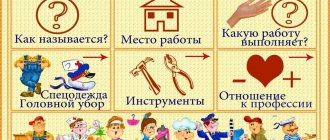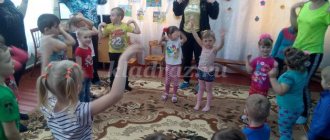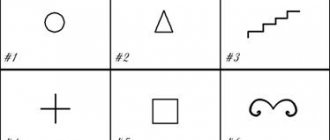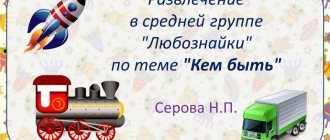Didactic games on the topic “Professions” 3-4 years
Didactic games
Didactic board game on the topic : “ Professions ”
.
for children 4-7 years old
Goal: expand children's understanding of various professions , their names and types of activities. Introduce tools and instruments needed by people of these professions and relate them. Foster respect for the work of adults.
Progress of the game: Participants are asked to take turns naming the professions that they already know and the tools that people in these professions , then try to correlate the actions of people with their profession , forming corresponding verbs from nouns (educator - educates, builder - builds, etc.)
.
The teacher draws the children's attention to the fact that unusual chests have appeared in the group, people of different professions , but they are empty, all the tools are mixed up, and people cannot work. Give the children a chest each. Then the adult invites one participant at a time to his table (everyone can sit at a round table)
. He takes the card and says what is shown on it. The rest of the children must name someone, this item is needed for work, and put it in the chest. If the children find it difficult to answer, explain what it is like with children, remember where they saw such an employee.
Let's show the doll how a hairdresser works
Goals:
· Clarify knowledge about the work of a hairdresser;
· Continue to formulate the idea of the need to maintain a clean body and a neat appearance.
Equipment:
2 dolls, attributes for playing hairdresser.
Contents of the game.
The teacher brings a large doll, which says that it came from another kindergarten, where the children do not know how to play hairdresser. The teacher asks to help the doll, tell and show how to play this game.
The teacher clarifies with the children what items are needed, how to prepare the place for the game, and offers to explain and show the actions of the hairdresser. The scope of actions depends on the children’s corresponding ideas.
Let's make beautiful hairstyles for the dolls
Goals:
· Strengthen the skills of caring for hair, etc.), asks to put them in order, to do their hair. She clarifies what items are needed for this, draws attention to the fact that the dolls’ hair is of different lengths, so their hairstyles should be different. The teacher suggests remembering what hairstyles can be made from long and short hair and shows some techniques; children continue to work with hair;
· Specify the names of the items required for this;
· Form the concept of “neat appearance.”
Equipment:
dolls with hair of different lengths, hair care items.
Contents of the exercise.
The teacher draws the children's attention to the unkempt appearance of the dolls (they are without socks and shoes, their hair is not neat)
«Determine the profession by subject
».
Goal: To consolidate an understanding of the purpose and functions of objects of labor, the ability to group them by method of use.
Procedure: Children take turns taking out objects from the bag (ladle, cotton wool, coins, comb, paint, threads, syringe, etc., which are necessary for one or another professional activity. Task: for the object, name the profession in which it is used.
"We're going to work"
Target:
teach children to navigate the space of the room, find their place in accordance with visual landmarks - pictures depicting professional symbols. Develop attention and memory during this game.
Game actions:
moving around the room (depicting a car ride) and finding a chair or place with the corresponding professional symbols (picture).
Game equipment:
“rudders” (circles with people of different professions drawn in the middle) are laid out on the teacher’s table; there are chairs in different places in the room, with pictures depicting tools on them.
Progress of the game:
the teacher invites the children to his table, everyone can choose a profession, take the steering wheel and go to work, to do this you need to carefully look at the chairs and choose a picture with a tool suitable for this job. The game is played several times, the teacher rearranges the pictures on the chairs, and the children must find their place again. Then the children change rudders (professions), and the game is repeated
“What does Masha want to do?”
Target:
clarify children’s ideas about certain work activities; about materials, tools and equipment needed for work.
Progress of the game: in
The teacher addresses the children on behalf of Masha (doll):
- Masha asks me for a basin, a bucket of water and soap.
Submits the objects she calls to the doll.
- What do you think she will do? (Wash.) That's right. And now Masha asks to give her a saucepan, milk, sugar, salt and millet. What is Masha going to do? (The doll wants to cook porridge.) What is the name of the porridge? (Millet.)
Other work activities that require appropriate items can be considered in a playful form. The kids are shown these items (an iron and a stack of doll's laundry - for ironing; a bucket and a watering can - for watering the beds, etc.).
When playing this game with older children, the teacher uses pictures depicting objects corresponding to a particular type of labor, or simply lists these objects (without showing illustrations), asking the children to guess more complex labor processes. For example: scissors, colored paper, glue, ruler, pencil - gluing books, repairing boxes, paraphernalia.
The game can be complicated: one child draws objects on the board, and the rest of the children guess the type of work, or all children simultaneously draw on paper, and then show the drawings to each other and guess.
«Guess what I'm doing?
Target
: expand children’s understanding of labor activities; develop attention.
Progress of the game:
The teacher and children join hands and stand in a circle. A child comes to the center of the circle. Everyone goes in a circle and says:
We don’t know what you’re doing,
Let's take a look and guess.
The child imitates labor actions not only with movements, but also (if possible) with sounds. For example, he cleans the floor with a vacuum cleaner, hammers a nail, saws, drives a car, does laundry, carries a bucket of water, wipes a mirror, chops wood, grates, turns something in a meat grinder, etc.
Children guess the actions.
“What do they do with this object?”
Target:
teach children to select words indicating the action performed by the object and who uses this object.
For example:
With a brush - (what are they doing?) - Drawing, (who?) - Artists, children.
With scissors - (what are they doing?) - Cutting, (who?) - Cutters, hairdressers.
With a needle - (what do they do?) - Sew, (who?) - Seamstresses, embroiderers.
With a shovel - (what are they doing?) - Digging, (who?) - Gardeners.
With a pen - (what do they do?) - Write, (who?) - Teachers, writers, accountants.
With an ax - (what are they doing?) - Chopping (who?) - Carpenters, foresters.
With a thermometer - (what are they doing?) - They measure the temperature, (who?) - Doctors, weather forecasters.
With a ruler - (what are they doing?) - Measuring, (who?) - Engineers, designers, schoolchildren.
With a broom - (what are they doing?) - Sweeping, (who?) - Janitors, etc.
“For a person in what profession is this necessary?”
Target:
expand children’s understanding of the items necessary for a person in a certain profession.
Progress of the game:
Scales, counter, goods, cash register... - to the seller.
Broom, shovel, hose, sand, crowbar, snow blower... - to the janitor.
Washing machine, bath, soap, iron... - to the laundress.
Comb, scissors, hair dryer, shampoo, hairspray, hair clipper... - to the hairdresser, etc.
"Guess the profession"
Target:
expand children’s understanding of the profession; find out what profession we are talking about.
Progress of the game:
This person is the owner of a wonderful palace of books. She is sincerely glad to see everyone who comes to visit her. And most importantly, guests will never leave her empty-handed. She gives them interesting books to take home. After reading, they can be exchanged for others. She will always help young and adult readers find the right book. (Librarian).
When you are hungry and come to the group for lunch, it already smells delicious. Who did this hard? Who prepared this tasty and aromatic dish? This is her favorite pastime, she does it with great love, that’s why everyone likes the food so much. For what a person does with pleasure and love brings joy not only to herself, but also to everyone else. Who is this? (Cook).
And this man greets his patient with a smile, quickly drives away unbearable pain, and cures all kinds of diseases. Once in his childhood, this man came to the aid of sick animals and loved ones, because he loved them very much and tried to reject the pain. And then I realized that I couldn’t live without it, so I studied for a long time and became (a Doctor).
When you come to kindergarten, everything around you is clean, comfortable, and fresh air. Not a speck of dust anywhere. The floor has been washed, the glass on the windows is so transparent that it is almost invisible. This person loves cleanliness very much and does his job with pleasure. She has great talent for this. Whose hands is this work? (Cleaners, assistant teacher).
The purpose of the didactic game “Professions”
The goal of the game is to expand and consolidate ideas about all kinds of professions, their characteristics and importance for society, the working tools used, and the products produced.
Game objectives:
- remembering the names of professions;
- expanding knowledge about the tools and devices needed to perform professional duties;
- clarification of the purpose and characteristics of professions;
- clarifying the idea of where people work, what clothes they wear, what actions they perform, and what their workplace looks like;
- developing an idea of what employees should know and be able to do;
- fostering a respectful and grateful attitude towards the work of others;
- developing an understanding that every profession is important, and the results of work are of great importance;
- instilling the desire to work hard and become a good worker;
- development of speech skills, the ability to think logically and perceive information by ear.
Progress of the game:
There is a stove in front of the children. On it is a pot, a frying pan (toys, quite large, or real dishes)
; next to it is a set of vegetables (natural, a bowl of water, a knife, a spoon.
Educator: - I will teach you how to cook delicious soup from vegetables! Standing on the stove (show)
. ?
- Large saucepan.
— There is water in this pan. Look (scoops up water with a spoon and pours it back)
.
The water will boil soon, so it's time to peel the potatoes .
The teacher asks one of the children to find and give him potatoes , washes them in a bowl, and peels them. Children name the actions and repeat the names.
The teacher asks what the potatoes .
-It is white, clean without skin (skin)
.
- Throw it into the pan whole or. ?
- We need to cut it.
The teacher puts the onions in the pan. Then the children bring cabbage and carrots and watch as the teacher washes and chops the vegetables. Separately, he fries the onion in a frying pan (the children name the vegetable and the action with it)
.
Educator: “Listen,” says the teacher, “how the oil sizzles in a hot frying pan: sh-sh-sh. How does it sizzle?
The teacher puts the onions in the pan and stirs the soup.
He says: “It’s a pity that it doesn’t burn.”
our stove. But now we’ll cook vegetables, vegetable soup, on a real stove.”
When the cook arrives, the teacher hands him the pan. He is interested in what is in it, listens to the children , approves and clarifies their answers. He promises to cook soup.
Note. It is advisable that vegetable soup be prepared for lunch on this day. This will bring joy to the children.
№ 13. "Who's doing what?"
.
Goal: to develop the ability to correlate a person’s actions with his professional activities ; cultivate respect for working people.
The teacher hands out cards depicting representatives of various professions . Then he shows object pictures depicting the object of their activity, while asking questions: “Who builds houses?”
;
“Who sews dresses?”
,
“Who sells milk?”
etc. Examples of
children's : “A builder builds houses
,
“A tailor sews dresses
,
“A salesman sells milk
.
№ 14. “Who needs what?”
.
Goal: to systematize knowledge about the professions of a cook and a doctor ; about the objects of their labor.
The teacher calls two children . One wears a chef's cap, the other wears a doctor's cap (with a red cross)
.
He seats them at the table facing the rest of the class participants. Invites a third child to the table. He invites him to take the thing out of the box and, naming it, hand it over to its destination: either the cook or the doctor. The one who received the thing must name it and tell what it is used for, for example: “This is a meat grinder, you can grind meat, bread, onions and make cutlets
.
During the game, the composition of its participants changes once or, if time permits, 2 times.
№ 15. "Parsley goes to work"
.
Objectives: To teach how to classify objects according to their functional purpose (satisfying labor needs)
; cultivate a desire to help adults.
Equipment: Pictures depicting items necessary for play and work in the garden, in the kitchen, in the apartment; three layouts (garden, kitchen, room)
Progress of the game: A letter arrives from Petrushka, in which he says that he is visiting his grandmother. He plays, draws, walks, and also helps his grandmother. Today she gave him three tasks: plant carrots in the garden and water the flowers; cook soup; clean up the room (put away toys, wipe off dust, vacuum)
. However, Petrushka got confused in the tools and asks the guys to help.
The teacher offers the children models of the garden, kitchen and room and explains that they need to take one picture , look carefully, name the item, tell how to use it and what kind of work it is needed for, then put the picture on the corresponding model. For example, a vacuum cleaner is needed to clean a rug, it needs to be turned on and vacuumed, so a picture with a picture of a vacuum cleaner needs to be placed on the room layout. The teacher draws the children's attention to the fact that among the pictures with tools there are pictures with toys . They need to be selected and put in a box. The task is considered completed if all the pictures are arranged correctly .
At the end of the game, the teacher invites the children to tell Petrushka in a letter what items he needs to complete his grandmother’s tasks.
№ 16. «Professions»
.
Goal: to develop an understanding of professions , enrichment and replenishment of the vocabulary of words; development of imagination, thinking, word formation skills.
Inventory: Not required.
Content: The presenter begins the sentence, the children must complete it by inserting the missing words. Or he asks a question, and the children answer. There are many options for such games; below are a few examples.




